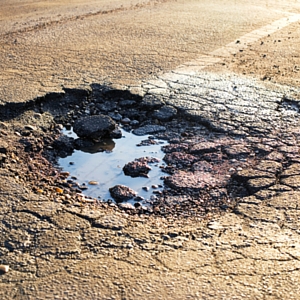How to Navigate Potholes

In 1958, a science fiction movie was released called "The Blob." In the movie, the Blob was a jelly-like substance that came out of a meteorite that struck the earth. The substance "ate" anyone and anything it came into contact with and got bigger and bigger the more it ate. Although potholes are not jelly-like, they are very similar to the Blob in one way—the longer they go without being fixed, the bigger they get, and the more damage they can cause to your car.
Potholes form when water seeps into pavement through cracks and eventually reaches the soil that supports the road. Temperature fluctuations cause the cracks to expand and contract, which weakens the soil below the road, and stress from traffic makes the weak areas weaker. Eventually, potholes can form in these weak areas. In the Midwest, we typically see more potholes after winter's extreme temperatures. The best thing you can do to protect your car from damage is to be aware of where they are so you can avoid them.
Pothole Avoidance Strategies
If you drive the same route every day, you probably have a pretty good idea of where the potholes are, which makes avoiding them a lot easier. If you're driving in an area you're less familiar with, here are a few helpful strategies:
- Look Ahead - Watching the road ahead of you on the road can help you avoid upcoming potholes, or at the very least, give you time to slow down.
- Don't tailgate! This can cause you to miss potholes you would have seen otherwise.
- Watch the cars in front of you—are they swerving? If so, something is in the road that needs to be avoided. Could be a pothole.
- Puddles can be deceiving—one might look shallow, but the water could be disguising a pothole.
- Slow down! The faster you're going, the harder you'll hit the pothole, risking damage not only to your tire, but also your wheel rims. It might even throw your alignment out of whack.
- Make sure your tires are properly inflated. Over-or under-inflation can cause can cause a tire to burst when it hits a pothole.
It Looks Like You're Going to Hit It!
Sometimes potholes sneak up on you, despite your best efforts to avoid them. Here's how to keep the damage minimal:
- Don't Brake. Instead, take your foot off the accelerator. Hitting the brakes hard pushes your suspension system further forward, which puts more weight in the front, which is usually where you hit the pothole. Physics will tell you what happens next.
- Don't Swerve. If you do, the tire can still hit the pothole at a weird angle, causing damage to the sidewall (which increases the likelihood of a blowout) and wheel rim. You also run a higher risk of needing an alignment.
And…You Hit It. Now What?
That loud sound when you hit a pothole is awful. You just know you've damaged something. We talk about car damage a lot in this article, but hitting a pothole doesn't always cause damage. If you aren't going too fast, or if the pothole isn't too big, chances are your car and tires are okay. To be sure, check your tires when you get out to be sure one isn't bulging or going flat. Also, if you notice your car pulling to one side or another, there's a chance you need an alignment. Potholes are notorious for causing a car to need an alignment.
The good news is in the spring, most cities have a way to report potholes and they try to get crews out to fix them as soon as possible. Just try to be patient—they probably have a lot to fix! Besides, now you know how navigate the bumpy roads until they are fixed.
-
Braving the Storm in Your Car
 See Tips
See TipsStorms can happen fast and catch you off guard. What would you do if you were driving and got caught in a storm or a tornado was in the area?
-
Crash Avoidance Technologies
 See How it Helps
See How it HelpsToday’s crash avoidance technology might not be able to keep you from hitting potholes, but it can help keep you safe in other ways.
-
Don't Get Dinged!
.jpg) See Ideas
See IdeasIf you don’t have a garage and kind find a public garage to park in when hail is in the forecast, here are some ways you can protect your car.
